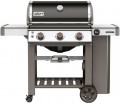Main burners
The number of individual burners or burners in a brazier (more precisely, a barbecue grill — see "Type"), powered by gas.
The presence of several burners provides additional options for adjusting the heating. For example, if not the entire work surface is occupied, some of the burners can be turned off, saving gas; by setting different heating intensity, you can fry different foods at the same time, etc. The more burners, the easier this adjustment is, usually, and the higher the price of the grill.
Burners power
The rated power of the burners (burners) in a gas grill (see “Fuel (source)”). In models with several burners, the total indicator is taken into account.
The heating intensity in almost all gas grills can be adjusted; therefore, the maximum thermal power is usually indicated as the rated power. In general, when choosing, this indicator has more of a reference value than a practical one. The fact is that manufacturers initially select the power of the burners taking into account the capacity and general purpose of the grill - so that it can successfully cope with its tasks. So the need to clarify the operating power arises mainly in specific cases - for example, if you plan to cook according to recipes that require very high heating intensity.
Working surface
The size of the working surface provided in the device, in length and width; for round surfaces, two sizes are also given (both of them correspond to the diameter).
Note that in many models these dimensions coincide with the overall dimensions in length and width (see "Dimensions (WxL)"), therefore, in some cases, information on the working surface may not be specified; a typical example is classic rectangular barbecues. There is also the opposite option — when only this parameter is given, without indicating the overall dimensions; in such cases, these dimensions usually also coincide with the dimensions of the working surface (or differ from them very slightly).
Anyway, the size of the working surface allows you to evaluate the total capacity of the product, as well as some other features. For example, for tandoors (see "Type"), the size of the neck can be given in this paragraph, but the firebox can be wider. However, anyway, two points should be taken into account. Firstly, it is necessary to take into account not only the dimensions, but also the shape of the surface; this is especially true for barbecue grills, where the options in form are quite diverse. Secondly, the larger size inevitably affects the dimensions and cost, and often also the weight of the device.
Dimensions (WxD)
Dimensions of the product deployed to the working position, in length and width; for round models, both of these dimensions are also indicated, just in such cases they are usually the same (equal to the diameter).
The general meaning of this characteristic is as follows: a larger product (with the same shape and type) usually has a larger capacity, but it turns out to be more bulky (including when folded, if such a possibility is provided), heavy and expensive. Moreover, in many cases, the overall dimensions in length and width correspond to the size of the working surface; a classic example is the traditional rectangular brazier, as well as many barbecue grills of the same shape. So if the data on the working surface (see below) are not separately indicated in the characteristics, then it may well be that the size of the brazier is equal to the overall dimensions (or differs very slightly from them). For a full guarantee in such cases, you should pay attention to the photographs of the product: if there are no shelves or other similar elements in the design that affect the length and width, then these dimensions can be used to estimate the dimensions of the working surface (that is, the total capacity and other related nuances ). For example, in the case of a traditional brazier, the width of the firebox determines the minimum length of the skewer (the skewer should be slightly longer to cover the firebox when installed across); and the number of places for skewers...directly depends on the length of the barbecue (ideally, there should be at least 60 mm between these places). If the dimensions of the working surface are given in the characteristics, then it is worth evaluating the practical capabilities of the product according to these dimensions; the overall dimensions in such cases only allow us to estimate the amount of space occupied by this model.
Also note that the height of the structure in the characteristics is indicated separately — in this case it has a different meaning than the length and width.
Weight
The total weight of the product, taking into account the main elements of equipment (lids, canopy, food stands, etc.), but excluding fuel.
It is worth evaluating this indicator taking into account the type of device. So, the most compact barbecues and barbecue grills can weigh
4-6 kg or even
less(in camping barbecues, the weight does not exceed these values at all);
7 – 10 kg for such models is considered an average, and larger values \u200b\u200bare typical mainly for large stationary structures of high capacity. But ceramic grills and tandoors are, by definition, massive: in the first case, even in the lightest models, the weight
exceeds 10 kg, in the second it is usually
more than 50 kg.
Anyway, note that both small and significant weight have their advantages. So, with similar functionality, a lighter device will be more convenient to transport, but this convenience will have to be paid for by reducing the height (which affects convenience), reducing the capacity and/or thinner walls of the furnace (which reduces reliability for metal walls, worsens for ceramic ones). efficiency). Conversely, a heavier structure will be more reliable, durable, often more spacious, but at the same time less convenient when moving from place to place, and often more cumbersome.

